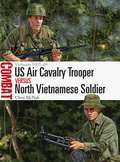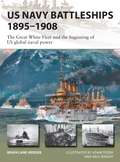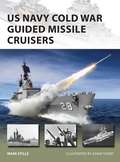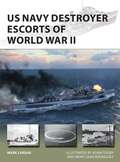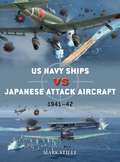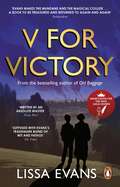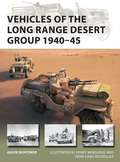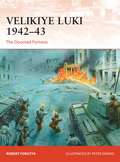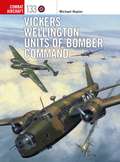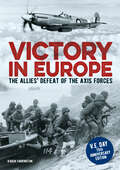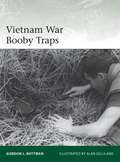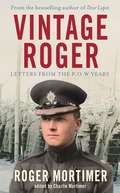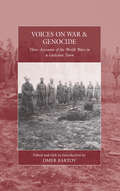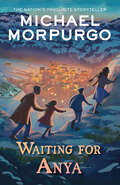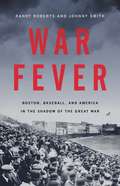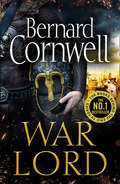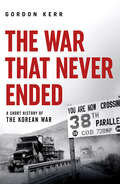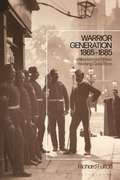- Table View
- List View
US Air Cavalry Trooper vs North Vietnamese Soldier: Vietnam 1965–68 (Combat)
by Chris McNabThe tactics and technologies of modern air assault – vertical deployment of troops by helicopter or similar means – emerged properly during the 1950s in Korea and Algeria. Yet it was during the Vietnam War that helicopter air assault truly came of age and by 1965 the United States had established fully airmobile battalions, brigades, and divisions, including the 1st Cavalry Division (Airmobile).This division brought to Vietnam a revolutionary new speed and dexterity in battlefield tactics, using massed helicopters to liberate its soldiers from traditional overland methods of combat manoeuvre. However, the communist troops adjusted their own thinking to handle airmobile assaults. Specializing in ambush, harassment, infiltration attacks, and small-scale attrition, the North Vietnamese operated with light logistics and a deep familiarity with the terrain. They optimized their defensive tactics to make landing zones as hostile as possible for assaulting US troops, and from 1966 worked to draw them into 'Hill Traps', extensive kill zones specially prepared for defence-in-depth. By the time the 1st Cavalry Division (Airmobile) withdrew from Vietnam in 1972, it had suffered more casualties than any other US Army division. Featuring specially commissioned artwork, archive photographs, and full-colour battle maps, this study charts the evolution of US airmobile tactics pitted against North Vietnamese countermeasures. The two sides are analysed in detail, including training, logistics, weaponry, and organization.
US Navy Battleships 1895–1908: The Great White Fleet and the beginning of US global naval power (New Vanguard #286)
by Brian Lane HerderThe last predreadnought battleships of the US Navy were critical to the technological development of US battleships, and they were the first tool of international hard power wielded by the United States, a nation which would eventually become the world's dominant political and military power of the 20th century. These battleships were the stars of the 1907–09 Great White Fleet circumnavigation, in which the emerging power and reach of the US Navy was displayed around the world. They also took part in the bombardment and landings at Veracruz, some served as convoy escorts in World War I, and the last two were transferred to the Hellenic Navy and were sunk during World War II. This book examines the design, history, and technical qualities of the final six classes of US predreadnought battleships, all of which were involved in the circumnavigation of the Great White Fleet. These classes progressively closed the quality gap with European navies – the Connecticuts were the finest predreadnought battleships ever built – and this book also compares and contrasts US predreadnought battleships to their foreign contemporaries. Packed with illustrations and specially commissioned artwork, this is an essential guide to the development of US Navy Battleships at the turn of the twentieth century.
US Navy Cold War Guided Missile Cruisers (New Vanguard #278)
by Mark StilleFaced with an increasingly formidable anti-ship cruise missile threat from the Soviet Union in the early days of the Cold War, and with the recent memory of the kamikaze threat from World War II, the USN placed a great priority on developing air defence cruise missiles and getting them to sea to protect the fleet. The first of these missiles were sizable, necessitating large ships to carry them and their sensors, which resulted in the conversion of a mix of heavy and light cruisers. These ships, tasked with protecting carrier groups and acting as flagships, entered service from 1955 and served until 1980. The cruisers served in the front lines of the Cold War and many saw combat service, engaging in surface actions from Vietnam to the Persian Gulf. Complementing the conventionally-powered missile cruisers was a much smaller number of expensive nuclear-powered cruisers, including the Long Beach, the USN's largest-ever missile cruiser. Until replaced by the Ticonderoga and Burke classes of Aegis ships, the USN's 38 missile cruisers were the most capable and important surface combatants in the fleet and served all over the globe during the Cold War. Using specially commissioned artwork and meticulous research, this illustrated title explores the story of these cruisers in unparalleled detail, revealing the history behind their development and employment.
US Navy Destroyer Escorts of World War II (New Vanguard #289)
by Mark LardasThe Destroyer Escort was the smallest ocean-going escort built for the United States Navy – a downsized destroyer with less speed, fewer guns, and fewer torpedoes than its big brother, the fleet destroyer. Destroyer escorts first went into production because the Royal Navy needed an escort warship which was larger than a corvette, but which could be built faster than a destroyer. Lacking the shipyards to build these types of ships in Britain, they ordered them in the US. Once the US unexpectedly entered World War II, its navy suddenly also needed more escort warships, even warships less capable than destroyers, and the destroyer escort was reluctantly picked to fill the gap. Despite the Navy's initial reservations, these ships did yeoman service during World War II, fighting in both the Atlantic and Pacific, taking on both U-boat and Japanese submarines and serving as the early warning pickets against kamikazes later in the war. They also participated in such dramatic actions as the Battle of Samar (where a group of destroyers and destroyer escorts fought Japanese battleships and cruisers to protect the escort carriers they were shielding) and the capture of the U-505 (the only major naval vessel captured at sea by the US Navy). The destroyer escorts soldiered on after World War II in both the United States Navy and a large number of navies throughout the world, with several serving into the twenty-first century. This book tells the full story of these plucky ships, from their design and development to their service around the world, complete with stunning illustrations and contemporary photographs.
US Navy Ships vs Japanese Attack Aircraft: 1941–42 (Duel #105)
by Mark StilleThe striking power of the Imperial Japanese Navy's carrier-based attack aircraft was established at Pearl Harbor, and the IJN's carrier-based torpedo and dive-bombers showed their prowess again at the Battle of Coral Sea when they sank the US Navy carrier USS Lexington and damaged the carrier USS Yorktown. Even at the disastrous Battle of Midway, the relatively small number of IJNAF attack- and torpedo-bombers that were launched against the US fleet proved that they remained a potent force by heavily damaging Yorktown again, which allowed an IJN submarine to sink the carrier. At Guadalcanal, IJNAF carrier-based aircraft sank the carrier USS Hornet and badly damaged USS Enterprise twice. However, throughout 1942, US Navy ship defences brought down an increasing number of attacking IJNAF aircraft. The final major battle of the year, the Battle of Santa Cruz, exacted crippling losses on the IJN, setting the stage for the eclipse of the IJNAF's highly trained and effective aviation attack forces. Packed with illustrations and contemporary photographs, this engrossing volume details the design, tactics, and operational records of both the US Navy ships and the IJNAF aircraft which attacked them over the year following Pearl Harbor.
V for Victory: The delightful and moving novel from the Sunday Times bestseller
by Lissa Evans'At once funny and moving: the brisk kindness of the wardens will bring a lump to your throat. I could not have loved it more' Susie SteinerIt’s late 1944. Hitler’s rockets are slamming down on London with vicious regularity and it’s the coldest winter in living memory. Allied victory is on its way, but it’s bloody well dragging its feet.In a large house next to Hampstead Heath, Vee Sedge is just about scraping by, with a herd of lodgers to feed, and her young charge Noel ( almost fifteen ) to clothe and educate. When she witnesses a road accident and finds herself in court, the repercussions are both unexpectedly marvellous and potentially disastrous – disastrous because Vee is not actually the person she’s pretending to be, and neither is Noel.The end of the war won’t just mean peace, but discovery...With caustic wit and artful storytelling, Lissa Evans elegantly summons a time when the world could finally hope to emerge from the chaos of war. As sharply comic as Old Baggage and emotionally poignant as Crooked Heart, V For Victory once again shows Lissa Evans to be one of our most brilliant and subtle writers.__________________________________Lissa Evans' writing is:Wise and witty - Sarah Hughes, ObserverOriginal and so timely. And it made me weep at the end. - JoJo MoyesBittersweet and comic. - GuardianInspiring, moving, warm and wry...wonderful! - Marian KeyesBeautifully written. -Sunday MirrorThoughtful, funny...invigoratingly fresh. - Sunday Times
The Vanishing Sky
by L. Annette BinderA story of the shattering impact of war on one German family, The Vanishing Sky is a deeply moving portrait of why decent, caring people falter when confronted by evil. They've wrecked the world, these men, and still they're not done. They'd take the sky if they could.Germany, 1945, and the bombs are falling. In Heidenfeld, Etta and her husband Josef roam an empty nest: their eldest son Max is fighting on the frontlines, while fifteen-year-old Georg has swapped books for guns at a Nürnberg school for the Hitler Youth. At home, news of the war provokes daily doses of fear as the planes grow closer, taking one city after the next.When Max is unexpectedly discharged, Etta is relieved to have her eldest home and safe. But soon after he arrives, it's clear that the boy who left is not the same returned. With Georg a hundred miles away and a husband confronting his own difficult feelings toward patriotic duty, Etta alone must gather the pieces of a splintering family, determined to hold them together in the face of an uncertain future.
The Vanishing Sky
by L. Annette BinderFor readers of Warlight and The Invisible Bridge, an intimate, harrowing story about a family of German citizens during World War II.“There was no shelter without her sons.”In 1945, as the war in Germany nears its violent end, the Huber family is not yet free of its dangers or its insidious demands. Etta, a mother from a small, rural town, has two sons serving their home country: her elder, Max, on the Eastern front, and her younger, Georg, at a school for Hitler Youth. When Max returns from the front, Etta quickly realizes that something is not right-he is thin, almost ghostly, and behaving very strangely. Etta strives to protect him from the Nazi rule, even as her husband, Josef, becomes more nationalistic and impervious to Max's condition. Meanwhile, miles away, her younger son Georg has taken his fate into his own hands, deserting his young class of battle-bound soldiers to set off on a long and perilous journey home.The Vanishing Sky is a World War II novel as seen through a German lens, a story of the irreparable damage of war on the home front, and one family's participation-involuntary, unseen, or direct-in a dangerous regime. Drawing inspiration from her own father's time in the Hitler Youth, L. Annette Binder has crafted a spellbinding novel about the choices we make for country and for family.
The Variety Girls
by Tracy BainesEven with the country at war, the show must go on... After the tragic death of her father, aspiring singer Jessie Delaney has been forced to live with her bullying aunt and dreams of getting the break of a lifetime to escape. When she's cast as one of the Variety Girls in a new show at the Empire Theatre, Jessie hopes this is the new beginning she's been longing for. But following her dreams on stage will mean being separated from sweetheart Harry.As she starts her new job, it's not long before she forms a close-knit friendship with Frances and Dolly, although the girls soon find that life in the theatre isn't always glamorous. And with the country on the brink of war, everyone is facing an uncertain future. Can friendship help Jessie through the challenges ahead?A gritty and heartwarming saga perfect for readers of Elaine Everest and Daisy Styles.
Vehicles of the Long Range Desert Group 1940–45 (New Vanguard #291)
by Gavin MortimerThe Long Range Desert Group was one of the most famous special units of World War II, operating heavily modified vehicles deep behind enemy lines to gather intelligence and support the raids of David Stirling's new Special Air Service.When war broke out, a pre-war explorer and army officer, Ralph Bagnold, convinced Middle East Command of the need for a reconnaissance force to penetrate into Italian-held desert. Bagnold tested four types of vehicles over rocks and through soft sand to find the best one for his new unit. Bagnold selected the Chevrolet WB (30 CWT) as the signature vehicle of the Long Range Desert Group because it is "fast, simple and easy to handle". With left-hand steering, horizontal grill and round fenders on the rear wheels, these trucks proved themselves popular and effective. The durability of the Chevrolets was demonstrated in January 1941 with an audacious raid on the Italian fort/air strip at Murzuk, hundreds of miles behind enemy lines.This book explains the detail of all the vehicles of the LRDG, as well as their modifications, driving techniques, and special kit for surviving behind enemy lines in one of the most hostile environments on earth.
Velikiye Luki 1942–43: The Doomed Fortress (Campaign #351)
by Robert ForczykVelikiye Luki had been an important Russian fortress city since the 13th century and had become an important rail-hub by the 19th century. In August 1941, the Germans occupied the city of 30,000 during Operation Barbarossa and made it a bulwark on the boundary between Heeresgruppe Nord and Heeresgruppe Mitte. In the winter of 1942–43, while Soviet forces were encircling Stalingrad, the Stavka (High Command) conducted a simultaneous offensive to isolate and destroy the 7,500-man German garrison in Velikiye Luki. After surrounding the city on 27 November 1942, the Soviet 3rd Shock Army gradually reduced the city to rubble, while the German garrison, sustained by Luftwaffe air lifts, hunkered down in the medieval city and awaited rescue. This illustrated title reveals the full story of the tense seven-week siege of Velikiye Luki, which saw Soviet forces striving to liberate the city in the face of a determined garrison and fierce relief efforts. Detailed analysis by renowned World War II historian Robert Forczyk is complimented by stunning and historically accurate battlescenes, maps, and bird's-eye-views to offer a comprehensive look at this gripping campaign.
A Very Stable Genius: Donald J. Trump's Testing of America
by Philip Rucker Carol D. Leonnig'In often alarming detail, A Very Stable Genius chronicles the wild ride of the Trump presidency' Guardian'Taut and terrifying . . . It reads like a horror story, an almost comic immorality tale . . . It's as if the president, as patient zero, had bitten an aide and slowly, bite by bite, an entire nation had lost its wits and its compass' New York Times'Takes us behind the scenes of the Trump presidency, where we learn that the private Trump is – if you can believe it – even worse than what you see every day' Washington PostThe definitive insider narrative and the most fully characterised account yet of the chaos, scandal and destruction of Trump's first term, from two Pulitzer Prize-winning Washington Post journalists.Drawing on nearly three years of reporting, hundreds of hours of interviews and more than two hundred sources, including some of the most senior members of the administration, friends and first-hand witnesses who have never spoken before, Philip Rucker and Carol Leonnig take us inside some of the most controversial moments of Trump's presidency. They peer deeply into Trump's White House – at the aides pressured to lie to the public, the lawyers scrambling to clear up norm-breaking disasters, and the staffers whose careers have been reduced to ashes – to paint an unparalleled group portrait of an administration driven by self-preservation and paranoia. Rucker and Leonnig reveal Trump at his most unvarnished, showing the unhinged decision-making and incompetence that has floored officials and stunned foreign leaders. They portray unscripted calls with Vladimir Putin, steak dinners with Kim Jong-un, and calls with Theresa May so hostile that they left her aides shaken. They also take a hard look at Robert Mueller, Trump's greatest antagonist to date, and how his investigation slowly unravelled an administration whose universal value is loyalty – not to country, but to the president himself.Grippingly told, A Very Stable Genius is a behind-the-scenes account of Trump's vainglorious pursuit of power in his first term – the rages and the frenzies, the dishonesty and the depravity – as his remaining loyal staffers eye the exits, and he stares down the reality of impeachment.
Vickers Wellington Units of Bomber Command (Combat Aircraft #133)
by Michael NapierThe Vickers Wellington was one of very few aircraft types to have been in production and frontline service throughout World War II, and more than 10,000 Wellingtons were built in the period. They took part in the first RAF bombing mission of the conflict when, on 4 September 1939, 14 examples from Nos 9 and 149 Sqns undertook a daring daylight attack on the Kiel Canal. However, after suffering high losses on follow-up raids, Wellingtons were withdrawn from daytime missions and began to operate at night from May 1940. They subsequently took part in raids against the Italian port city of Genoa in July 1940, and against Berlin the following month, followed by key missions in the 'Battle of the Barges' in September and October, as the RAF targeted the Germany's invasion fleet being assembled in French Channel ports. When RAF's strike force expanded the next year following the introduction of the improved Wellington II, the 21 squadrons equipped with the Vickers aircraft, which included Polish-, Canadian- and Australian-manned units, formed the backbone of the Bomber Command night bombing force. Over the next two years Wellingtons participated in all the major operations by Bomber Command, including the daylight raid against German battleships in Brest harbour in July 1942 and the first three 'Thousand Bomber' raids in the summer of 1942.This illustrated study explores the design, development, and deployment of the Vickers-Wellington type, charting its role in World War II from its earliest missions to its use in training after its withdrawal from frontline bomber missions in 1943. The text is supported by stunning full-colour artwork.
Victory: The Triumph and Tragedy of Just War
by Cian O'DriscollCommitting one's country to war is a grave decision. Governments often have to make tough calls, but none are quite so painful as those that involve sending soldiers into harm's way, to kill and be killed. The idea of 'just war' informs how we approach and reflect on these decisions. It signifies the belief that while war is always a wretched enterprise it may in certain circumstances, and subject to certain restrictions, be justified. Boasting a long history that is usually traced back to the sunset of the Roman Empire, it has coalesced over time into a series of principles and moral categories—e.g., just cause, last resort, proportionality, etc.—that will be familiar to anyone who has ever entered a discussion about the rights and wrongs of war. Victory: The Triumph and Tragedy of Just War focuses both on how this particular tradition of thought has evolved over time and how it has informed the practice of states and the legal architecture of international society. This book examines the vexed position that the concept of victory occupies within this framework.
Victory in Europe: The Allies' Defeat of the Axis Forces
by Karen FarringtonOperation Overlord was one of the greatest ever military offensives, working to free Europe from the yoke of Nazism. Starting with the landings on D-Day, Victory in Europe traces the Allied struggle to create a foothold in "Fortress Europe". Overcoming initial setbacks, the final crossing of the Rhine and the advance into Germany changed the course of European history forever. This gripping story is told from the perspective of the service men at the centre of the operation, and how their bravery and doggedness made the defeat of Hitler's hordes possible.Illustrated with over 100 black and white photos and maps, Victory in Europe is a thrilling read on the final offensive push against Adolf Hitler.Features:• Normandy landings• The liberation of Paris• Battle of the Bulge• The fall of Berlin• VE Day
Vietnam War Booby Traps (Elite #236)
by Gordon L. RottmanDuring the Vietnam War, the Viet Cong were frequently unable to hold their own in stand-up fights against US and allied forces who were superior in strength, firepower, mobility, and logistics. They relied instead on traditional guerrilla warfare tactics including small-scale hit- and-run attacks, ambushes, terrorist actions, and precision attacks against bases. These included one of the oldest of guerrilla weapons – the boobytrap. Booby traps could be made in large numbers in village workshops and jungle camps using locally available materials as well as modern munitions. The VC were adept at making booby traps 'invisible' in the varied terrain of Vietnam, often emplacing them in locations and surroundings totally unexpected by their enemies. Booby traps could be incredibly simple or startlingly complex and ingenious, ranging from pointed sticks to command-detonated submerged floating river mines. Besides a wide variety of booby traps, they also used land and water mines, both contact/pressure-detonated and command-detonated. Between January 1965 and June 1970 11 percent of US troop deaths in action and 17 percent of injuries were by caused booby traps and mines. This fascinating title explores not only the wide variety of booby traps employed by the Viet Cong, but also their various uses in halting, stalling, or locating an enemy, and the many evolutions these traps underwent in order to retain the element of surprise. Written by a Vietnam veteran with first-hand experience of such traps, this is an engaging look at one of the most frightening aspects of guerrilla warfare.
Vintage Roger: Letters from the POW Years
by Roger Mortimer'I think prison has done me very little harm and some good. I am now far better read, far less smug and conceited, far more tolerant and considerably more capable of looking after myself.'In 1930, 21-year-old Roger Mortimer was commissioned into the 3rd Battalion Coldstream Guards, and would spend the next eight years stationed at Chelsea Barracks. He lived a fairly leisurely existence, with his parents' house in Cadogan Gardens a stone's throw away, and pleasant afternoons were whiled away at the racecourse or a members' club - officers in the battalion were even allocated 'soldier servants'. Admittedly things got a little hairy in Palestine in 1938, when Roger, now a captain, found himself amidst the action in the Arab Uprising. The worst, however, was yet to come. While fighting the Germans in 1940, Roger was knocked unconscious by a shell explosion - he was then incorrectly reported to have been killed in action. Upon waking he was delighted to find that he had survived. Though he was somewhat less delighted to find that he was now a Prisoner of War. Thus began a period of incarceration that would last five long years, and which for Roger there seemed no conceivable end in sight. Vintage Roger is Roger Mortimer at his witty, irreverent best. Exuding the charm and good humour that captured the nation's hearts in Dear Lupin and Dear Lumpy, this uplifting account tells of Roger's years in the Coldstream Guards and is followed by a collection of letters he wrote to his good friend Peggy Dunne from May 1940 to late 1944. Steadfastly optimistic and utterly captivating, the letters paint a vivid portrait of life as a POW.
Vixen: a gripping crime thriller (Georgina Garrett Series #3)
by Sam MichaelsWhile World War Two rages on around them, the gangs of London are fighting for their turf... There might be a war on, but that doesn't stop Georgina Garrett running her business with an iron fist. No one said running the Battersea gang was going to be easy, but her unflinchable nature makes Georgina unstoppable. With a role that requires a ruthless ability to seek revenge and pay out crippling punishments, Georgina's enemies are growing in number. With a target on her back, Georgina knows she must do everything to protect her family. But, with the loss of someone closest to her, can Georgina rise up from the ashes or allow a usurper take her crown? Perfect for fans of Peaky Blinders, Martina Cole and Lesley Pearse.
Voices on War and Genocide: Three Accounts of the World Wars in a Galician Town (War and Genocide #30)
by Omer BartovTaking as its point of departure Omer Bartov’s acclaimed Anatomy of a Genocide, this volume brings together previously unknown accounts by three individuals from Buczacz. These rare narratives give personal glimpses into daily life in unsettled times: a Polish headmaster during World War I, a Ukrainian teacher and witness to both Soviet and German rule, and a Jewish radio technician, genocide survivor, and member of the Polish resistance. Together, they offer a prismatic perspective on a world remote from our own that nonetheless helps us understand how people not unlike ourselves responded to mass violence and destruction.
Waiting for Anya
by Michael MorpurgoA gripping World War II adventure from War Horse author and former Children's Laureate, Michael Morpurgo. Jo did not stop until he’d shut the door behind him and even then his heart could not stop pounding in his ears.
War Fever: Boston, Baseball, and America in the Shadow of the Great War
by Randy Roberts Johnny SmithA "richly detailed" portrait of the three men whose lives were forever changed by WWI-era Boston (Michael S. Neiberg): baseball star Babe Ruth, symphony conductor Karl Muck, and Harvard Law student Charles Whittlesey.In the fall of 1918, a fever gripped Boston. The streets emptied as paranoia about the deadly Spanish flu spread. Newspapermen and vigilante investigators aggressively sought to discredit anyone who looked or sounded German. And as the war raged on, the enemy seemed to be lurking everywhere: prowling in submarines off the coast of Cape Cod, arriving on passenger ships in the harbor, or disguised as the radical lecturing workers about the injustice of a sixty-hour workweek.War Fever explores this delirious moment in American history through the stories of three men: Karl Muck, the German conductor of the Boston Symphony Orchestra, accused of being an enemy spy; Charles Whittlesey, a Harvard law graduate who became an unlikely hero in Europe; and the most famous baseball player of all time, Babe Ruth, poised to revolutionize the game he loved. Together, they offer a gripping narrative of America at war and American culture in upheaval.
War Lord (The Last Kingdom Series #13)
by Bernard CornwellIN THE FINAL RECKONING, CHOOSE YOUR SIDE CAREFULLY… The epic conclusion to the globally bestselling historical series.
The War That Never Ended: A Short History of the Korean War
by Gordon KerrThe Korean War of 1950-1953 ended in a frustrating stalemate, the echoes of which reverberate to this day. It was the only conflict of the Cold War in which forces of major nations of the two opposing systems - capitalism and communism - confronted each other on the battlefield. And yet, in the sixty years since it was fought it has been strangely neglected, perhaps because no one was able to claim the victor's spoils. A Short History of the Korean War details the origins, battles, politics and personalities of the war that never ended.Praise for Gordon Kerr'Informative, fascinating and extremely well-researched...Gordon Kerr's book is a mini masterpiece' - Rob Minshull, ABC Brisbane on A Short History of the Vietnam War'Factual and even-handed, Kerr presents a fair-minded introduction of basic Chinese history' - Booklist on A Short History of China
Warrior Generation 1865-1885: Militarism and British Working Class Boys
by Richard FultonRichard Fulton's Warrior Generation 1865-1885 fundamentally rethinks the efficacy of an institutional drive among influential middle-class opinion leaders to militarize lower-class boys in Victorian Britain. He contends that instead of engendering the desired cultural militarism, as has been commonly argued, their push had merely contributed to a fast-developing culture of adventure and masculinity.Challenging this popular assumption, Fulton carefully reexamines many of the oft cited touchstones of militaristic influence on lower-class boys, deeply assessing their actual effects on the behaviours and cultural practices of this generation. He explores a range of themes from, among others, the propagation of the military's message in school curricula (and its glorification in students' textbooks), to the military's heroic depiction and ubiquitous presence in lower-class boys' entertainment and popular media.
Warsaw 1920: The War for the Eastern Borderlands (Campaign #349)
by Steven J. ZalogaThe Battle of Warsaw in August 1920 has been described as one of the decisive battles of European history. At the start of the battle, the Red Army appeared to be on the verge of advancing through Poland into Germany to expand the Soviet revolution. Had the war spread into Germany, another great European war would have ensued, dragging in France and Britain. However, the Red Army was defeated by 'the miracle on the Vistula'. This campaign title explores the origins and outcomes of this momentous battle. In May 1920, the Polish Army intervened in war-torn Ukraine, pushing all the way to Kiev, but the Red Army, by now triumphant in most of the theatres of the Russian Civil War, turned its attention to this new threat. By the late summer of 1920, two Soviet armies had advanced into Poland and the overconfident Soviet leadership dreamed of advancing over a prostrate Polish Army into neighbouring Germany to ignite a Communist revolution in the heart of Europe.Thanks to the low density of forces on both sides and the huge distances involved, the conflict was a war of manoeuvre, with a curious mixture of traditional and advanced tactics. Horse cavalry played a dominant role in the fighting, but aeroplanes, tanks, and armoured trains lent the war an air of modernity. This illustrated study explores the war through the lens of the Battle of Warsaw, the turning point when, after a summer of disastrous retreat, the Polish army rallied and repulsed the Red Army at Warsaw and Lwow.
